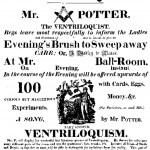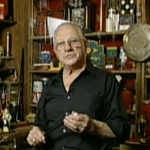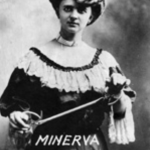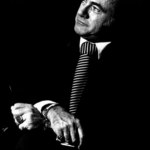by John Booth, Excerpt from Memoirs of a Magician’s Ghost
Armed with a Sony tape recorder, I returned to the Goulets’ magic center after a hiatus of several years. My first visit should have included note making. But, I was so inundated with details and a need to sort them out before I could describe them in writing that I promised to come back.
After attending the 1992 Yankee Magic Collectors’ gathering in Salem Massachusetts, Ray Goulet picked me up at the College Club whcre I was staying on Commonwealth Avenue in Boston. This was the first residence established in the United States for women graduates of universities. After it became illegal for most clubs and institutions to be restricted to one sex, it opened its venerable doors to male university graduates. Nevertheless, I think that I was the token male residing there. Unfortunately for me, most of the women were too elderly for even this superannuated coot.
It was a cool, dark fall evening when Ray unlocked the door of his magic shop and led me through it to another door opening into his ‘‘mini museum” as he chooses to call it. We started with his gamblers’ devices collection. Many are displayed in turn-of the century glass candy cases which Ray was lucky to purchase.
Various types of shells for the old shell game intrigued me. This ‘‘trick’’ was once a favorite close-up item in my table work. One set on display was made of handcarved wood; another made of pewter was decorated with three dwarfs painted on them; a Brema set was included.
Faro boxes are dead relics of olden times, but Ray showed me one that was doctored so that the dealer could tell four cards ahead. A holdout constructed by Bob Haskell, strictly for gambling lectures, looked authentic but was not practical.
“Holdouts made for magicians aren’t very aaccurate,’’ Ray says, “not like the gamblers’ holdouts.”
Different kinds of loaded dice and switching cups rested beside bugs with pins or clips on them to shove up under tables or fasten to table cloths. Luminous glasses and marked cards vied for attention along with a pocket watch containing a roulette wheel.
‘‘Nothing in this room is for sale,’’ declared Ray as he glanced at the shelves loaded from floor to ceiling with all manner of conjuring-related articles.
We moved on to small objects, mostly made of boxwood. Morrison Pill Boxes that once sold for $1.00 to $1.50 now command $300 or more, depending on their condition. Wooden cups for the Cups and Balls, the Skittle, ;and a French set of Nest of Boxes (of early manufacture) are a contrast to a Conradi Handkerchief to Banana (made of wood).
I have a photograph, taken by Ann, of Ray showing mc a metal container used by Fred Kaps to receive coins plucked from the air. As Fred pretended to drop each coin into the ‘‘bucket,’’ his hand touched a catgut loop which pulled up a coin fastened inside and dropped it with a clunk matching the motion of his hand.
The Dutch manipulator’s large hands enabled him to work with 3” aluminum disks, anodized with gold. Kaps milled the blanks himself; a harlequin was stamped on each of the 24 coins in the Goulet collection, currently evaluated at $100.00 each.
On the shelves in the photograph are sets of Cups and Balls spun in copper, tin and aluminum: ball vases of various types, canisters, small cabinets and wooden blocks decorated in a multitude of designs.
Fifty and more years ago, a popular stunt was to produce eight alarm clocks from a hat, each one ringing with a slightly different note. Sets made by Abbott and Marshall look enviously at a Donald Holmes set which has a giant clock to bring out as a climax to the production..
In Conradi’s book Exquisite Magic, he describes a “Flight of Time” in which four silver bells – like sleigh bells – are removed from a ribbon and seemingly tossed through the air. One by one, they reappear jangling loudly on the end of four ribbons ahnging from a frame across the stage. David Devant presented his version of the’ ‘‘
This set Ray’ and me to chatting about the dramatic version developed by Harry Houdini and his master mechanic, James Collins. Several alarm clocks resting on a stand were picked up, one by one, and tossed invisibly across the stage. Each clock visibly arrived, swinging from a chain or ribbon below a simple framework, each sounding a different note.
When I mentioned seeing Hardeen, Houdini’s brother, perform the feat in Cleveland’s 105th Street Theater in the late 1920’s, Ray remarked: “Bill Rauscher, who formerly owned Houdini’s clock equipment, did it best of all! It never failed. The timing of the bells was all-important.’’
Two subdivisions of equipment collecting are (A) apparatus made by various dealers across the generations (B) apparatus used by notable conjurians in history. The Goulets have acquired good examples within each of these categories.
Roterberg constructed the Billiard Ball Stand and two Card Stars (selected cards suddenly appear on the tips of each point of a large star), and a cage transposition.
Richard Cardini, a bird fancier as well as a superb manipulator, built the birdcage and wrist reel.
Martinka was responsible for the 12 nested German Water Jars, a beautiful act.
Schlosser built, at the start of the 1900’s, a ponderous rose bush growth at the request of Otto Hornmann. A metal table weighing 125 pounds and carried in an even heavier trunk was required. The bush was concealed in the table’s single cast iron leg, topped by a three-inch-deep, round metal table top, out (if which the rose bush actually emerged. Stage electricians were told to keep lights off the bottom of the table in order to conceal the operative thread which ran across the stage. Girls would water the plant at intervals, a running gag as the plant slowly grew. All this engineering for a simple effect was sold by Hornmann to Houdini in 1903 for $3400.00! Hardeen is said to have confirmed the accuracy of this account.
Ray Goulet’s major interest has always centered on the history and products of New England’s own legendary magical metalsmith John Albert Petrie and his Petrie-Lewis Manufacturing Company in New Haven, Connecticut. Whereas Carl Brema in Philadelphia turned out masterpieces in metal largely for pocket-sized tricks, P & L as it is often called, was noted for the highest quality craftsmanship in metal products used with cigarettes, cards, candles, bags, balls, rings and other articles for stand-up entertainers.
Only six or seven of the scores of products designed and built on the P & L benches are said to be absent from Ray Goulet’s collection,
We examined a P & L Carousel trick involving seven cages, built especially for Dell O’l)elI at the peak of her career. Our eyes feasted on Rice Bowls, Phantom Tubes, Drumhead Productions, Comedy Funnels, Changing Bags, Glass Through Hat Candlesticks, Vanishing Alarm Clocks, and a multitude of other basic effects of club and stage magic.
But we must move on, the category of props that once gave fame and fortune to celebrated magicians is also richly endowed in the Watertown mini-museum. We see one of Houdini’s personal straitjackets and, a gift from Canon Rauscher, a costume worn by Bcssie Houdini and a magnificent set of Chinese Sticks (Hindu Wands) specially made by Carl Brema for the escapist.
Silent Mora’s self-built Duck Tub Production (from between his legs) using a harness given him by China’s great Ching Ling Foo. Mora (Louis McCord) made almost everything in his act.
Herman Hanson is represented by The Phoenix Cage and an Expanding Egg from which came a rooster. Ray presented this trick 12 times on the Bozo network television show across the years.
Blackstone’s Block Release from a ribbon was a gift of Herman Hanson. It is not the similar effect of Booth’s Baffling Block which was manufactured and sold by the Blackstone Magic Company 60 years ago.
Tricks used by Kaps, Hartz, Val Evans, Okito’s father, Arthur Lloyd and others too numerous to mention stand ready for some performer to bring them to life in a show. “Thirty years ago these items were called ‘used magic’ and sold cheaply,” mused Ray, looking fondly at them. “Today, we call them ‘collectibles’ and they sell for many times their original cost. However, I repair into working order any article that conies into my museum.’’
Alexander Herrmann’s handgun used to shoot a borrowed finger ring into a nest of suspended boxes impressed me the most. Carried in a rough wooden box, probably constructed on the road by his carpenter, it resembles a 15” long dueling pistol. In the box are dozens of finger rings of various styles anti sizes from which one could be taken that matched somewhat the volunteer’s ring. Switched into sight, it was loaded into the muzzle of the gun while an assistant (or perhaps Herrmann himself) secretly inserted the true ring unto the final, smallest box iii due time.
My visit was capped by Ray and I sitting down to look over many examples of sheet music related to magic or used in the shows of Howard Thurston, Adelaide Herrman, Robert Heller, Edgar Bergen, Dell O’Dell, and others. There is even ‘ Oriental Mazurka’’ written by John Petrie! But I must write of this another day.
Ann and Ray Goulet have created a little bit of magician’s heaven here on earth. In three connected stores, magic is taught eager students. Without leaving the premises, they can purchase the magic they want and need, gaining immediate instruction in how to use it. The latest magazines and books are available from which to choose. Stepping into the mini-theatre, they can rehearse, experiment and create an act. For inspiration, a colorful museum is open to them. Monthly meetings of an I.B.M. Ring offer fellowship, lectures and swap opportunities. Presiding over it all is a kindly, informed and skilled magician, a mentor, friend and inspiration.
What a combination, a Mecca, to provide a siren call to magical pilgrims wherever they may be!
‘The P&L Book, edited by Barbi Walker and Robert Seaver (published by Byron Walker In 1992), is a handsome, hard cover, 276 page definitive work indispensable to every collector and history buff.








